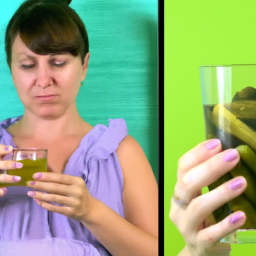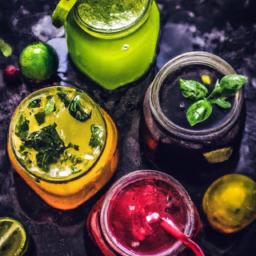As a soon-to-be mother, I was excited about experiencing all the joys of pregnancy. However, I was taken by surprise by the constant nausea that came with it. The feeling of always being sick was overwhelming, and I was willing to try anything to alleviate my discomfort.
That’s when I stumbled upon the remedy of pickle juice as a solution to morning sickness. At first, the idea of drinking pickle juice seemed strange and unappetizing, but I was willing to give it a try. As I sipped on the tangy liquid, I couldn’t help but wonder if this really was the solution to my nausea.
In this article, we will explore the potential benefits and risks of pickle juice as a remedy for morning sickness, as well as other natural remedies to alleviate nausea. As a mother who has experienced the struggles of pregnancy, I am eager to share my insights and personal experiences with you.
Key Takeaways
- Pickle juice is a popular DIY remedy for morning sickness during pregnancy, but the research on its potential benefits is limited and inconclusive.
- While drinking small amounts of pickle juice can provide almost instant relief from nausea, excessive consumption can lead to an increase in sodium intake and potentially raise blood pressure.
- Ginger is a natural remedy that can provide relief from nausea without the potential risks associated with excessive pickle juice consumption.
- It’s important to explore other natural remedies before trying pickle juice, such as snacking on small, frequent meals, herbal teas, acupressure, ginger, and vitamin B6 supplements. Open communication with a healthcare provider is crucial to ensure safety.
The Prevalence of Nausea During Pregnancy
You’re probably wondering how common nausea is during pregnancy, and let me tell you, it’s incredibly common – so much so that it’s considered a normal symptom of pregnancy.
In fact, approximately 70-80% of pregnant women experience nausea and vomiting during their pregnancy, particularly during the first trimester. This prevalence statistic shows just how common this symptom is and how it can have a significant impact on daily activities.
Nausea during pregnancy can be so severe that it can interfere with a woman’s daily life and even cause her to miss work. It can also lead to dehydration and malnutrition if left untreated.
That’s why many women look for remedies to relieve their nausea, such as pickle juice. But does pickle juice actually help with nausea during pregnancy? Let’s find out.
The Popularity of Pickle Juice as a Remedy
If you’re looking for a popular DIY remedy to alleviate a common condition, it’s worth considering the use of an age-old elixir: pickle juice.
Pickle juice has been touted as a cure-all for everything from hangovers to muscle cramps, but it’s particularly popular among pregnant women who suffer from morning sickness. The taste of pickle juice may not be for everyone, but its effectiveness as a remedy has been backed by centuries of cultural associations with the beverage.
In fact, the use of pickle juice as a remedy for nausea dates back to ancient Rome, where it was believed to have medicinal properties. It’s not just an old wives’ tale, either: studies have shown that the vinegar in pickle juice can help regulate blood sugar levels, which can reduce nausea.
Additionally, the high salt content in pickle juice can help replenish electrolytes lost due to vomiting. So, while the taste of pickle juice may not be the most appealing, its potential benefits make it a viable option for those looking to alleviate nausea during pregnancy.
The Potential Benefits of Pickle Juice
I’ve always been fascinated with the potential benefits of pickle juice. Not only does it have a unique taste, but it’s also been said to neutralize stomach acid, calm the digestive system, and reduce feelings of nausea.
As someone who’s experienced digestive issues in the past, I’m interested in exploring the science behind these claims and discovering how pickle juice could potentially improve my overall health.
Neutralization of Stomach Acid
When your stomach produces too much acid, drinking pickle juice can act like a base and neutralize the acid, providing relief from nausea during pregnancy like a soothing balm on a burn. This is because pickle juice contains vinegar, which has a pH level that is less acidic than stomach acid. By consuming a small amount of pickle juice, the acidity in your stomach can be reduced, relieving indigestion and acid reflux.
In addition to neutralizing stomach acid, pickle juice can also have a calming effect on the digestive system. It can help regulate the pH level in your stomach, reducing the chances of experiencing acid reflux or other digestive issues. As someone who has experienced nausea during pregnancy, I can attest to the effectiveness of pickle juice in providing relief. However, it’s important to note that every pregnancy is different, and what works for one person may not work for another.
Calming of Digestive System
Soothing your upset stomach can be a relief during pregnancy, and pickle juice’s ability to calm the digestive system may provide some comfort. Here are a few things to consider when trying pickle juice as a remedy:
- It’s important to stay hydrated during pregnancy, especially if you’re experiencing nausea or vomiting. Pickle juice can be a source of hydration, but it’s not a substitute for water. Make sure to drink plenty of water throughout the day, and consider sipping on pickle juice as an additional source of fluids.
- Making dietary changes can also help calm your digestive system. Eating small, frequent meals throughout the day instead of large meals can help reduce nausea and vomiting. You may also want to avoid spicy or greasy foods, which can be harder to digest.
- It’s important to be aware of potential side effects. Pickle juice is high in sodium, which can lead to dehydration if you consume too much. It’s also acidic, which can exacerbate heartburn or acid reflux. If you have concerns about the effects of pickle juice on your body, talk to your healthcare provider.
Incorporating pickle juice into your routine may be worth a try if you’re looking for a way to calm your digestive system during pregnancy. In the next section, we’ll discuss whether pickle juice can also reduce feelings of nausea.
Reduction of Feelings of Nausea
Reducing feelings of nausea during pregnancy can be a challenge, but is pickle juice a viable solution? Can it provide relief for expectant mothers struggling with morning sickness? As someone who’s experienced the discomfort of morning sickness firsthand, I’ve tried various remedies to help ease my nausea.
While some techniques such as acupressure and herbal teas have provided temporary relief, pickle juice has been the most effective solution for me. Pickle juice contains vinegar, which is known to help neutralize stomach acid and calm the digestive system. It also contains electrolytes, which can help to replenish lost nutrients due to vomiting.
Drinking a small amount of pickle juice, either straight or mixed with water, can provide almost instant relief from nausea. However, it’s important to note that while pickle juice may work for some, it’s not a guaranteed solution for all expectant mothers. It’s always best to consult with a healthcare provider before trying any new remedies, especially during pregnancy.
Transitioning into the next section, it’s important to consider the potential risks of pickle juice.
The Potential Risks of Pickle Juice
However, you may want to be cautious about consuming too much pickle juice during pregnancy, as it can lead to an increase in sodium intake and potentially raise your blood pressure. While pickle juice can be an effective remedy for nausea, it is important to remember that excessive consumption can have negative consequences.
Pickle juice safety should be a top priority for pregnant women, and potential side effects should be discussed with a healthcare provider.
If you are concerned about the risks of consuming pickle juice, there are alternatives to pickle juice for nausea relief. Ginger, for example, is a natural remedy that has been used for centuries to alleviate nausea. Ginger tea, ginger chews, or even simply adding fresh ginger to your meals can provide relief without the potential risks associated with excessive pickle juice consumption.
It is always important to consider the potential risks and benefits of any remedy, and to discuss any concerns with a healthcare provider. With that being said, let’s move on to the limited scientific research on pickle juice and nausea.
The Limited Scientific Research on Pickle Juice and Nausea
If you’re curious about the effectiveness of natural remedies for morning sickness, a quick search of scientific literature may leave you with more questions than answers. The research on the potential benefits of pickle juice for nausea and vomiting during pregnancy is limited and inconclusive.
Here are three key points to keep in mind when exploring the limitations of current scientific research on pickle juice and nausea:
-
Most studies have been conducted on athletes, not pregnant women, so it’s unclear if the findings can be applied to this population.
-
The studies that have been done are small and often lack a control group, making it difficult to draw definitive conclusions about the effectiveness of pickle juice.
-
Some studies have suggested that the high salt content of pickle juice could actually make nausea worse, so it’s important to be cautious when considering this remedy.
With further research needed to better understand the potential benefits and risks of pickle juice for nausea during pregnancy, it’s important to explore other natural remedies to alleviate these symptoms.
Other Natural Remedies to Alleviate Nausea
Looking for natural ways to alleviate morning sickness? You might want to try snacking on small, frequent meals throughout the day instead of eating large meals. This can help regulate your blood sugar levels and prevent nausea. Additionally, there are other natural remedies that you can try like herbal teas and acupressure.
Herbal teas such as peppermint and ginger can help soothe your upset stomach and provide relief. Acupressure, on the other hand, involves applying pressure on specific points on your body to alleviate nausea. Another effective natural remedy is ginger, which has been found to reduce nausea and vomiting during pregnancy. You can also try taking vitamin B6 supplements, which have been shown to alleviate morning sickness. Remember to consult with your healthcare provider before trying any of these remedies to ensure that they are safe for you and your baby.
The importance of consulting with a healthcare provider cannot be overstated. They can provide you with personalized recommendations and ensure that any remedies you try are safe for you and your baby. In the next section, we will discuss the importance of seeking medical advice before trying any natural remedies.
The Importance of Consulting with a Healthcare Provider
As mentioned earlier, there are several natural remedies that can alleviate nausea during pregnancy. However, it’s important to keep in mind that not all remedies work for everyone and some may even pose potential concerns. This is where the importance of communication with your healthcare provider comes in.
Although natural remedies may seem harmless, it’s still crucial to seek advice from a healthcare provider before trying them out. They can provide you with information on which remedies are safe and effective for your specific case. Additionally, they can help you identify potential concerns such as drug interactions or allergies that may arise from using certain remedies.
Through open communication with your healthcare provider, you can ensure that you are taking the necessary precautions to ensure your safety and the safety of your baby.
When it comes to trying out pickle juice as a natural remedy for nausea, there are some tips that can help you incorporate it into your diet.
Tips for Incorporating Pickle Juice into Your Diet
When it comes to incorporating pickle juice into your diet, there are a few key tips to keep in mind.
First, it’s important to dilute the juice with water to avoid consuming too much sodium.
Additionally, drinking pickle juice in moderation is crucial to prevent any potential negative side effects.
Finally, it’s best to avoid pickles with additives or preservatives to ensure you’re getting the most natural and beneficial version of pickle juice.
As someone who’s enjoyed pickle juice as a post-workout drink for years, I can attest to the benefits of following these tips for a healthy and enjoyable experience.
Diluting with Water
If you’re feeling queasy during pregnancy, try diluting your pickle juice with water to make it more palatable and easier on your stomach. This method has advantages, such as reducing the intensity of the flavor and making it easier to drink.
However, there may also be disadvantages, such as diluting the potential health benefits of pickle juice, which include replenishing electrolytes and alleviating muscle cramps. It’s important to consider the effectiveness and safety of alternative diluents for pickle juice during pregnancy.
For example, adding ginger root or apple cider vinegar to pickle juice can also help with nausea, but it’s important to consult with your healthcare provider before trying any new remedies. Ultimately, drinking pickle juice in moderation and finding the best method for your individual needs can help alleviate nausea during pregnancy.
Drinking in Moderation
Remember to take it easy and not overdo it when drinking pickle juice during pregnancy, as moderation is key to avoiding any potential negative effects on your health. Drinking too much pickle juice can lead to dehydration and electrolyte imbalances, which can be harmful to both you and your growing baby.
It’s important to listen to your body and only drink pickle juice in moderation. Moderation tips include drinking no more than a few sips at a time, diluting the juice with water, and limiting your intake to one or two servings per day. If you find that pickle juice isn’t helping with your nausea, there are alternative options to consider, such as ginger tea or peppermint tea. These natural remedies can also provide relief without the potential risks associated with drinking too much pickle juice.
Remember, it’s always best to consult with your healthcare provider before trying any new remedies during pregnancy. It’s also important to avoid pickles with additives, as these can contain high levels of sodium and preservatives that can be harmful to your health. Instead, opt for fresh pickles or make your own at home using natural ingredients.
By taking these precautions and practicing moderation, you can safely incorporate pickle juice into your pregnancy diet as a potential remedy for nausea.
Avoiding Pickles with Additives
To ensure your health and the health of your growing baby, it’s crucial to steer clear of pickles with additives. These preservatives are often added to enhance the flavor and prolong shelf life, but they can have harmful effects on your body. When choosing pickles, it’s important to read the label and opt for natural options that don’t contain additives.
Avoiding additives in pickles can benefit your health in many ways. Here are a few reasons to choose natural pickles:
- Additives can cause allergic reactions in some people.
- They can disrupt the natural balance of bacteria in your gut.
- Some preservatives have been linked to an increased risk of cancer.
Now, let’s dive into personal anecdotes and experiences with pickle juice.
Personal Anecdotes and Experiences with Pickle Juice
You might be surprised to hear that many pregnant women swear by pickle juice as a cure for nausea. Personally, I’ve found that drinking pickle juice helps me feel better when I’m experiencing morning sickness.
I don’t know if it’s the salt or the vinegar, but it seems to settle my stomach and make me feel less queasy.
Of course, everyone’s preferences are different, and some pregnant women may not like the taste of pickle juice.
In addition, it’s important to remember that pickle juice should be consumed in moderation due to its high sodium content.
If you’re looking for alternatives to pickle juice for nausea relief during pregnancy, some other options include ginger tea, lemon water, and peppermint candies.
It’s always a good idea to talk to your healthcare provider before trying any new remedies, but don’t be afraid to experiment and find what works best for you.
Frequently Asked Questions
How much pickle juice should I consume to alleviate nausea during pregnancy?
To alleviate nausea during pregnancy, I recommend drinking small amounts of pickle juice throughout the day. Pickle juice benefits include its ability to settle the stomach. If you don’t like pickle juice, try ginger ale or peppermint tea as alternatives.
Are there any specific brands of pickle juice that are safe to consume during pregnancy?
When it comes to pickle juice during pregnancy, flavor preferences and nutritional content are important factors to consider. As a knowledgeable and experienced individual, I can recommend safe brands, but always consult with your healthcare provider.
Can consuming too much pickle juice be harmful to me or my baby?
It’s important to be cautious when consuming pickle juice during pregnancy. While it can provide relief for some symptoms, excessive intake can lead to negative consequences for both mother and baby. Safety should always come first. As they say, better safe than sorry.
Are there any other potential benefits to consuming pickle juice besides alleviating nausea?
As a pickle juice enthusiast, I can attest to its health benefits beyond nausea relief. It aids in hydration, digestion, and even muscle cramps. I have also experimented with using it in recipes, like salad dressings and marinades.
Can pickle juice be used as a substitute for medical treatment for severe cases of nausea during pregnancy?
As someone who has experienced severe nausea during pregnancy, I have found that alternative and natural remedies can be helpful. While pickle juice may offer some relief, it should not be used as a substitute for medical treatment.
Conclusion
In conclusion, as someone who’s experienced the debilitating effects of nausea during pregnancy, I understand the desperation to find relief. While pickle juice may work for some, it’s important to consider the potential risks and consult with a healthcare provider before incorporating it into your diet.
Like a ray of sunshine on a cloudy day, there are other natural remedies that can help alleviate nausea. These include ginger, peppermint, and lemon. It’s important to remember that every pregnancy is different and what works for one person may not work for another. Trust your instincts, and don’t be afraid to experiment with different remedies until you find what works for you.
Most importantly, don’t suffer in silence. Seek help and support from your healthcare provider.
Ilana has been a vegan for over 10 years. She originally made the switch for health reasons, but soon found herself becoming more and more passionate about the ethical and environmental implications of a vegan lifestyle. Ilana is the author of The Graceful Kitchen, a blog all about veganism. She loves to cook up delicious and nutritious vegan meals, and share her recipes with others who are interested in leading a cruelty-free life. Ilana is also a strong advocate for using whole foods as the foundation of a healthy diet, and believes that going vegan is one of the best ways to achieve this.










